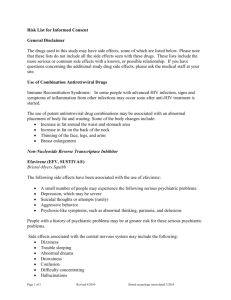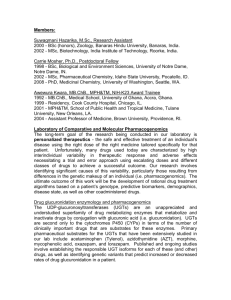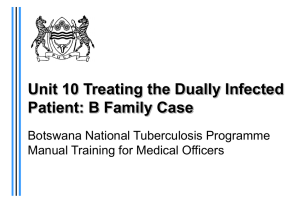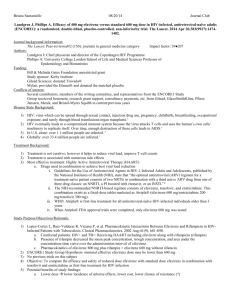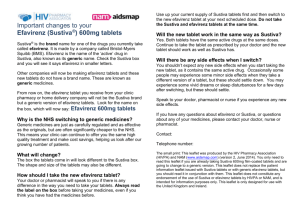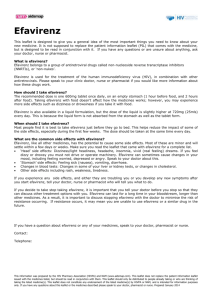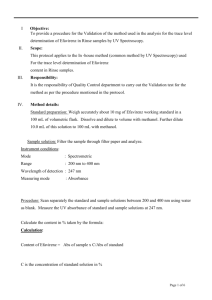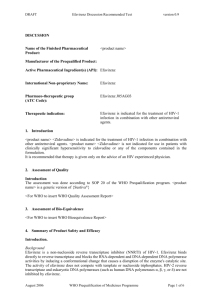Document 13308808
advertisement
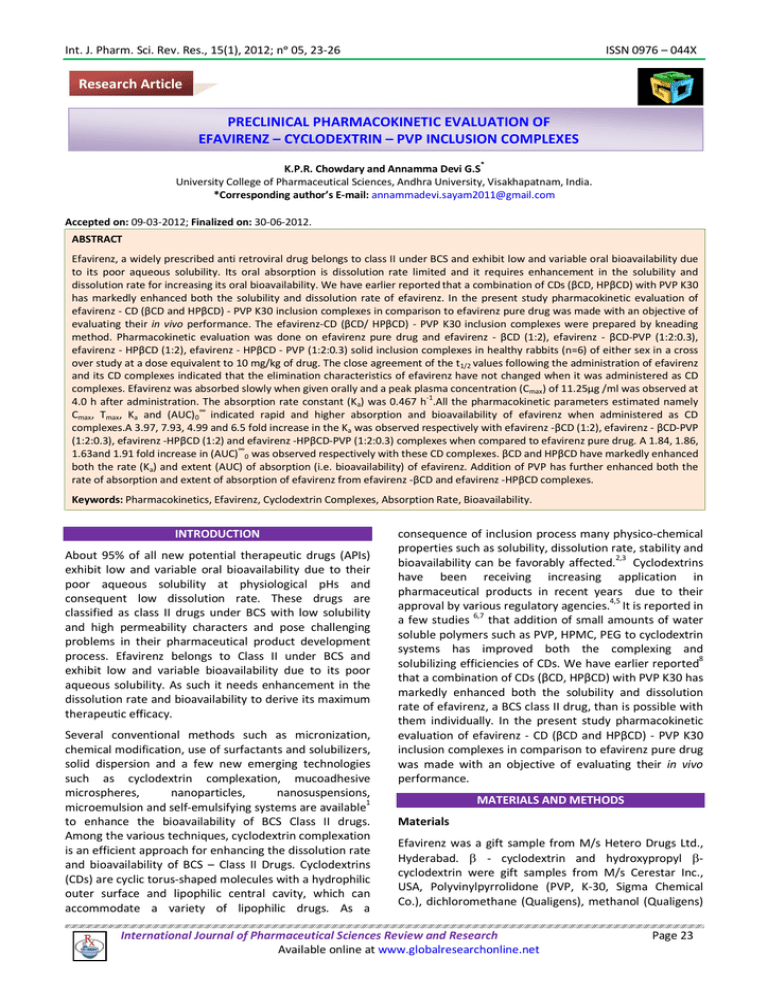
Int. J. Pharm. Sci. Rev. Res., 15(1), 2012; nᵒ 05, 23-26 ISSN 0976 – 044X Research Article PRECLINICAL PHARMACOKINETIC EVALUATION OF EFAVIRENZ – CYCLODEXTRIN – PVP INCLUSION COMPLEXES * K.P.R. Chowdary and Annamma Devi G.S University College of Pharmaceutical Sciences, Andhra University, Visakhapatnam, India. *Corresponding author’s E-mail: annammadevi.sayam2011@gmail.com Accepted on: 09-03-2012; Finalized on: 30-06-2012. ABSTRACT Efavirenz, a widely prescribed anti retroviral drug belongs to class IΙ under BCS and exhibit low and variable oral bioavailability due to its poor aqueous solubility. Its oral absorption is dissolution rate limited and it requires enhancement in the solubility and dissolution rate for increasing its oral bioavailability. We have earlier reported that a combination of CDs (βCD, HPβCD) with PVP K30 has markedly enhanced both the solubility and dissolution rate of efavirenz. In the present study pharmacokinetic evaluation of efavirenz - CD (βCD and HPβCD) - PVP K30 inclusion complexes in comparison to efavirenz pure drug was made with an objective of evaluating their in vivo performance. The efavirenz-CD (βCD/ HPβCD) - PVP K30 inclusion complexes were prepared by kneading method. Pharmacokinetic evaluation was done on efavirenz pure drug and efavirenz - βCD (1:2), efavirenz - βCD-PVP (1:2:0.3), efavirenz - HPβCD (1:2), efavirenz - HPβCD - PVP (1:2:0.3) solid inclusion complexes in healthy rabbits (n=6) of either sex in a cross over study at a dose equivalent to 10 mg/kg of drug. The close agreement of the t1/2 values following the administration of efavirenz and its CD complexes indicated that the elimination characteristics of efavirenz have not changed when it was administered as CD complexes. Efavirenz was absorbed slowly when given orally and a peak plasma concentration (Cmax) of 11.25µg /ml was observed at -1 4.0 h after administration. The absorption rate constant (Ka) was 0.467 h .All the pharmacokinetic parameters estimated namely ∞ Cmax, Tmax, Ka and (AUC)0 indicated rapid and higher absorption and bioavailability of efavirenz when administered as CD complexes.A 3.97, 7.93, 4.99 and 6.5 fold increase in the Ka was observed respectively with efavirenz -βCD (1:2), efavirenz - βCD-PVP (1:2:0.3), efavirenz -HPβCD (1:2) and efavirenz -HPβCD-PVP (1:2:0.3) complexes when compared to efavirenz pure drug. A 1.84, 1.86, ∞ 1.63and 1.91 fold increase in (AUC) 0 was observed respectively with these CD complexes. βCD and HPβCD have markedly enhanced both the rate (Ka) and extent (AUC) of absorption (i.e. bioavailability) of efavirenz. Addition of PVP has further enhanced both the rate of absorption and extent of absorption of efavirenz from efavirenz -βCD and efavirenz -HPβCD complexes. Keywords: Pharmacokinetics, Efavirenz, Cyclodextrin Complexes, Absorption Rate, Bioavailability. INTRODUCTION About 95% of all new potential therapeutic drugs (APIs) exhibit low and variable oral bioavailability due to their poor aqueous solubility at physiological pHs and consequent low dissolution rate. These drugs are classified as class II drugs under BCS with low solubility and high permeability characters and pose challenging problems in their pharmaceutical product development process. Efavirenz belongs to Class II under BCS and exhibit low and variable bioavailability due to its poor aqueous solubility. As such it needs enhancement in the dissolution rate and bioavailability to derive its maximum therapeutic efficacy. Several conventional methods such as micronization, chemical modification, use of surfactants and solubilizers, solid dispersion and a few new emerging technologies such as cyclodextrin complexation, mucoadhesive microspheres, nanoparticles, nanosuspensions, 1 microemulsion and self-emulsifying systems are available to enhance the bioavailability of BCS Class II drugs. Among the various techniques, cyclodextrin complexation is an efficient approach for enhancing the dissolution rate and bioavailability of BCS – Class II Drugs. Cyclodextrins (CDs) are cyclic torus-shaped molecules with a hydrophilic outer surface and lipophilic central cavity, which can accommodate a variety of lipophilic drugs. As a consequence of inclusion process many physico-chemical properties such as solubility, dissolution rate, stability and bioavailability can be favorably affected.2,3 Cyclodextrins have been receiving increasing application in pharmaceutical products in recent years due to their approval by various regulatory agencies.4,5 It is reported in a few studies 6,7 that addition of small amounts of water soluble polymers such as PVP, HPMC, PEG to cyclodextrin systems has improved both the complexing and solubilizing efficiencies of CDs. We have earlier reported8 that a combination of CDs (βCD, HPβCD) with PVP K30 has markedly enhanced both the solubility and dissolution rate of efavirenz, a BCS class II drug, than is possible with them individually. In the present study pharmacokinetic evaluation of efavirenz - CD (βCD and HPβCD) - PVP K30 inclusion complexes in comparison to efavirenz pure drug was made with an objective of evaluating their in vivo performance. MATERIALS AND METHODS Materials Efavirenz was a gift sample from M/s Hetero Drugs Ltd., Hyderabad. - cyclodextrin and hydroxypropyl cyclodextrin were gift samples from M/s Cerestar Inc., USA, Polyvinylpyrrolidone (PVP, K-30, Sigma Chemical Co.), dichloromethane (Qualigens), methanol (Qualigens) International Journal of Pharmaceutical Sciences Review and Research Available online at www.globalresearchonline.net Page 23 Int. J. Pharm. Sci. Rev. Res., 15(1), 2012; nᵒ 05, 23-26 were procured from commercial sources. All other materials used were of Pharmacopoeial grade. Methods Estimation of efavirenz ISSN 0976 – 044X Model: SPD – 10AVP), C-18 column (Phenomenex, DESC: Gemini 5µ C18 110A, Size: 250 X 4.6 mm, S/No: 288063 – 23), 2 pumps (Model: LC – 10 ATVP) and a micro syringe ® of capacity 25µl (Model: Microliter # 702, Mfd. by: M/s Hamilton). A UV Spectrophotometric method based on the measurement of absorbance at 245 nm in water containing 2% SLS was used for the estimation of efavirenz in in vitro studies. The method was validated for linearity, accuracy, precision and interference. The method obeyed Beer’s law in the concentration range of 1-10 µg/ml. When a standard drug solution was repeatedly assayed (n=6), the relative error and coefficient of variance were found to be 0.68% and 1.02% respectively. No interference by the excipients used in the study was observed. Chromatographic Conditions Preparation of Efavirenz-CD (βCD/ HPβCD) - PVP K30 Complexes Retention Time of Internal Standard: 2.975 min Pharmacokinetic Evaluation Pharmacokinetic evaluation of efavirenz-CD (βCD / HPβCD) - PVP K30 inclusion complexes prepared in comparison to efavirenz pure drug was done in healthy rabbits weighing 1.5 – 2.5 kg (n=6) of either sex in a cross over study at a dose equivalent to 10 mg/kg of drug. Pharmacokinetic evaluation was done on efavirenz pure drug and efavirenz - βCD (1:2), efavirenz - βCD -PVP (1:2:0.3), efavirenz - HPβCD (1:2), efavirenz - HPβCD - PVP (1:2:0.3) solid inclusion complexes. In vivo study protocols were approved by the Institutional Animal Ethics Committee (Regd. No 516/01/a/CPCSEA). A wash out period of one month was given between testing of two products. After collecting the zero hour blood sample (blank), the product in the study was administered orally in a capsule shell with 10 ml of water. No food or liquid other than water was permitted until 4 hours following the administration of the product. Blood samples (2 ml) were collected from marginal ear vein at 0.5, 1, 2, 3, 4, 6, 8 and 12 hours after administration. The blood samples were collected in heparinized tubes and were centrifuged at 10000 rpm for 10 min and the plasma separated was collected into dry tubes. All the samples were stored under refrigerated conditions prior to assay on the same day. Plasma concentrations of efavirenz were determined by a known9 HPLC method after revalidation as follows. Instrumentation The HPLC system (Make: M/s Shimadzu Corporation, Japan.) consisted of UV-Visible detector (Shimadzu, Internal Standard: Metadoxine (4µg/ml). Detection: The column effluent was monitored at 266 nm. Retention Time of Efavirenz: 7.027 min For the estimation of efavirenz in plasma samples, a calibration curve (Fig. 1) was constructed initially by analyzing plasma samples containing different amounts of efavirenz as follows: To a series of tubes containing 0.5 mL of drug free plasma in each, 0.1 mL of internal standard solution containing 4µg of metadoxine and 0.1 mL drug solution containing 2, 4, 6, 8 and 10 µg of efavirenz were added and mixed. To each tube 1 mL of acetonitrile was added, mixed thoroughly and centrifuged at 5000 rpm for 20 min. The organic layer (0.5 mL) was taken into a dry tube and the acetonitrile was evaporated. To the dried residue 0.5 mL of mobile phase was added and mixed for reconstitution. Subsequently 20 µL were injected into the column for HPLC analysis. From the time versus plasma concentration data, various pharmacokinetic parameters such as peak concentration (Cmax), time at which peak occurred (Tmax), Area under the curve (AUC), elimination rate constant (Kel), biological half - life (t1/2), percent absorbed to various times and absorption rate constant (Ka), were calculated in each case as per known standard methods10, 11. y = 0.102x - 0.003 R² = 0.999 1.2 1 Ratio of A2/A1 Solid inclusion complexes of efavirenz-CD (βCD / HPβCD) PVP K30 were prepared by kneading method. Efavirenz, βCD/ HPβCD and PVP K30 were triturated in a mortar with a small volume of solvent consisting of a blend of water: methanol (1:1). The thick slurry formed was kneaded for 45 min and then dried at 55oC until dry. The dried mass was powdered and sieved to mesh No. 120. Mobile Phase: The mobile phase consists of a mixture of 0.1 M formic acid –acetonitrile-methanol (43:52:5). The mobile phase was filtered through a 0.45µm membrane filter before use and was run at a flow rate of 1 ml/min. 0.8 0.6 0.4 0.2 0 0 2 4 6 8 10 Concentration (µg/0.5 ml Plasma) Figure 1: Calibration curve for the Estimation of Efavirenz in Plasma Samples International Journal of Pharmaceutical Sciences Review and Research Available online at www.globalresearchonline.net Page 24 Int. J. Pharm. Sci. Rev. Res., 15(1), 2012; nᵒ 05, 23-26 ISSN 0976 – 044X RESULTS AND DISCUSSION The efavirenz-CD (βCD/ HPβCD) - PVP K30 inclusion complexes were prepared by kneading method with a view to enhance the solubility and dissolution rate of efavirenz, a BCS class II drug. All the solid inclusion complexes of efavirenz-CD (βCD/ HPβCD) - PVP K30 prepared were found to be fine and free flowing powders. Low coefficient of variation (c.v) values (< 1%) in the percent drug content indicated uniformity of drug content in each batch of solid inclusion complexes prepared. The dissolution rate characteristics of these efavirenz-CD (βCD/ HPβCD) - PVP K30 inclusion complexes 8 were reported earlier . In the present study pharmacokinetic evaluation was done on efavirenz-CD (βCD / HPβCD) - PVP K30 inclusion complexes in comparison to efavirenz pure drug with an objective of evaluating their in vivo performance. Plasma concentrations of efavirenz following the oral administration of efavirenz and its CD complexes are shown in Fig.2. Pharmacokinetic parameters estimated are summarized in table 1. Figure 2: Plasma concentrations of efavirenz following the oral administration of efavirenz and its CD complexes Table 1: Summary of Pharmacokinetic Parameters Estimated Following the Oral Administration of Efavirenz and CD Complexes Product Cmax (µg/ml) Tmax (h) Kel -1 (h ) t1/2 (h) 12h ∞ (AUC)0 (µg.h /ml) (AUC)0 (µg.h/ml) BA (%) Ka -1 (h ) MRT (h) Percent Absorbed 0.5 h 1.0 h 2.0 h Efavirenz 11.25 4.0 0.1464 4.73 82.1075 105.87 100.0 0.467 6.94 24.04 39.82 54.94 Efv-βCD(1:2) 23.80 2.0 0.1547 4.48 161.0325 195.29 184.46 1.857 5.53 67.15 84.37 100 Efv- βCDPVP(1:2:0.3) 28.12 1.0 0.1614 4.29 167.825 197.688 186.72 3.705 5.67 82.04 97.53 100 Efv-HPβCD (1:2) 23.45 1.0 0.166 4.17 143.45 172.66 163.08 2.33 6.15 73.5 90.28 100 Efv-HPβCD-PVP (1:2:0.3) 28.32 1.0 0.166 4.17 172.545 202.36 191.14 3.043 5.54 88.1 95.22 100 The biological half- life (t1/2) estimated from the elimination phase of the plasma level curves was found to be 4.73, 4.48, 4.29, 4.17 and 4.17 h respectively following the oral administration of efavirenz, and its CD complexes efavirenz - βCD (1:2), efavirenz - βCD -PVP (1:2:0.3), efavirenz - HPβCD (1:2), efavirenz - HPβCD - PVP (1:2:0.3) . The close agreement of the t1/2 values in the five cases indicated that the elimination characteristics of efavirenz have not changed when it was administered as CD complexes. Efavirenz was found to be absorbed slowly when given orally and a peak plasma concentration (Cmax) of 11.25µg /ml was observed at 4.0 h after administration. The absorption rate constant (Ka) was found to be 0.467 h-1. All the pharmacokinetic parameters (Table 1) namely Cmax, Tmax, Ka and (AUC)0∞ indicated rapid and higher absorption and bioavailability of efavirenz when administered as CD complexes. Higher Cmax values and lower Tmax values were observed with the CD complexes when compared to those of efavirenz as such. The absorption rate constant (Ka) was found to be 1.857h-1, -1 -1 -1 3.705h , 2.33 h and 3.043h respectively with efavirenz –βCD (1:2), efavirenz – βCD - PVP (1:2:0.3), efavirenz – HPβCD (1:2) and efavirenz –HPβCD - PVP (1:2:0.3) complexes, whereas in the case of efavirenz Ka was only 0.467 h-1. A 3.97, 7.93, 4.99 and 6.5 fold increase in the Ka was observed respectively with efavirenz -βCD (1:2), efavirenz - βCD-PVP (1:2:0.3), efavirenz -HPβCD (1:2) and efavirenz -HPβCD-PVP (1:2:0.3) complexes when ∞ compared to efavirenz pure drug. (AUC)0 (extent of absorption) was also much higher in the case of CD complexes when compared to efavirenz pure drug. (AUC)0∞ was increased from 105.87µg.h /ml for efavirenz to 195.29, 197.688, 172.66 and 202.36 µg.h /ml for efavirenz -βCD(1:2), efavirenz - βCD-PVP(1:2:0.3), efavirenz -HPβCD(1:2) and efavirenz -HPβCD-PVP(1:2:0.3) complexes respectively. A 1.84, 1.86, 1.63and 1.91 fold increase in (AUC)∞0 was observed respectively with efavirenz -βCD(1:2), efavirenz - βCD-PVP(1:2:0.3), efavirenz -HPβCD(1:2) and efavirenz -HPβCD-PVP(1:2:0.3) complexes when compared to efavirenz pure drug. Thus βCD and HPβCD have markedly enhanced both the rate (Ka) and extent (AUC) of absorption (i.e. bioavailability) of efavirenz. Addition of PVP has further enhanced both the rate of absorption and extent of absorption of efavirenz from efavirenz -βCD and efavirenz -HPβCD complexes. International Journal of Pharmaceutical Sciences Review and Research Available online at www.globalresearchonline.net Page 25 Int. J. Pharm. Sci. Rev. Res., 15(1), 2012; nᵒ 05, 23-26 ISSN 0976 – 044X CONCLUSION 1. 2. 3. 4. 5. REFERENCES The close agreement of the t1/2 values following the administration of efavirenz and its CD complexes indicated that the elimination characteristics of efavirenz have not changed when it was administered as CD complexes. Efavirenz was absorbed slowly when given orally and a peak plasma concentration (Cmax) of 11.25µg /ml was observed at 4.0 h after administration. The -1 absorption rate constant (Ka) was 0.467 h . All the pharmacokinetic parameters estimated namely Cmax, Tmax, Ka and (AUC)0∞ indicated rapid and higher absorption and bioavailability of efavirenz when administered as CD complexes. A 3.97, 7.93, 4.99 and 6.5 fold increase in the Ka was observed respectively with efavirenz -βCD (1:2), efavirenz - βCD-PVP (1:2:0.3), efavirenz -HPβCD (1:2) and efavirenz -HPβCD-PVP (1:2:0.3) complexes when compared to efavirenz pure drug. A 1.84, 1.86, 1.63and 1.91 fold increase in (AUC)∞0 was observed respectively with these CD complexes. βCD and HPβCD have markedly enhanced both the rate (Ka) and extent (AUC) of absorption (i.e. bioavailability) of efavirenz. Addition of PVP has further enhanced both the rate of absorption and extent of absorption of efavirenz from efavirenz -βCD and efavirenz -HPβCD complexes. 1. Chowdary, K.P.R., and Madhavi, B.L.R., Novel Drug Delivery Technologies for Insoluble Drugs, Indian Drugs, 42(9), 2005, 557. 2. Holvet, C., Heyden, Y.V. and Plaizer –Vercanmmen, J., Inclusion complexation of diazepam with different cyclodextrins in formulations for parenteral use, Pharmazine, 60(8), 2005, 598. 3. Veda, H., Ou, D., Endo, T. , Narge, H., Tomono, K. and Nagari, T., Drug Dev. Ind. Pharm., 24(9), 1998, 863. 4. Thomson, D.O., Cyclodextrins-enabling Excipients: Their Present and Future Use in Pharmaceuticals. Crit. Rev. Ther. Drug Carries Syst., 14, 1997, 1. 5. Hedges, A.R., Industrial Applications of Cyclodextrins. Chem. Rev., 98, 1998, 2035. 6. Koester, L.S., Mayorga, P. and Bassani, V.L., Carbamazepine/betaCD/HPMC solid dispersions. II. Physical characterization., Drug Dev. Ind. Pharm., 29(2), 2003, 139. 7. Mura, P., Faucci, M.T. and Bettinetti, G.P., The influence of polyvinylpyrrolidone on naproxen complexation with hydroxypropyl-beta-cyclodextrin., Eur. J. Pharm. Sci., 13, 2001, 2001, 187. 8. Chowdary, K.P.R. and Annamma Devi G.S., Effect of PVP on Cyclodextrin Complexation of Efavirenz for Enhancing Its Solubility and Dissolution Rate, Int. J. Res. Pharm. Chem., 2(2), 2012, 311-316. 9. Seloi, Mogatle and Isadore, Kanfer., Rapid method for the quantitative determination of efavirenz in human plasma. J. Pharm. Biomed. Anal., 49 (5), 2009, 1308. 10. Wagner, J. G. and Nelson, Per cent absorbed time plots derived from blood level and/or urinary excretion data, E., J. Pharm. Sci., 52, 1963, 610. 11. Wagner, J. G. and Nelson, Kinetic Analysis of Blood Levels And Urinary Excretion in the Absorptive Phase After Single Doses of Drug, E., J. Pharm. Sci., 53, 1964, 1392. ********************* International Journal of Pharmaceutical Sciences Review and Research Available online at www.globalresearchonline.net Page 26
